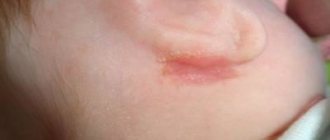Full breathing of children through the nose at night is extremely important, since the oxygen supplied with the air enriches the brain and internal organs, which is a necessary condition for good health and vigor. If a child has a stuffy nose at night, then his brain does not receive enough oxygen, as a result of which he wakes up lethargic, irritated and tired.
In addition, passing through the nasal cavity, oxygen is moistened, warmed and cleared of dust and pathogenic organisms, and if the nose is stuffy at night, the child is forced to breathe with an open mouth, which leads to drying out of the mucous membranes of the oropharynx and upper respiratory tract and increases the risk of developing a viral infection. - infectious diseases - tonsillitis, pharyngitis, laryngitis.
Why does my nose get stuffy at night?
There are several main reasons that can lead to disruption of full nasal breathing, these include:
- Swelling of the mucous membranes of the nasal cavity - this condition is an integral part of the pathological process and is characterized by increased blood flow to the inflamed area. At the same time, the blood vessels in the nasal cavity expand and thereby increase the volume of the mucous membranes. This condition causes the nasal passages to narrow or become completely blocked for a period of time, preventing air from entering the airways through the nose. The condition worsens when the child takes a horizontal position, as blood flows more strongly to the head.
- A large amount of mucous discharge has accumulated in the nose, which closes the nasal passages like a plug - if the mucus is liquid, then it comes off easily (possibly flows down the back wall of the throat), but if the discharge is thick, then the child cannot blow it out and because of this can't breathe through his nose.
- Pathological conditions and diseases.
There are different types of runny nose: finding out the reasons
The main causes of runny nose in children are:
- viral infections (in 90% of cases);
- bacterial infections (attached in the later stages);
- allergens: plant pollen, animal hair, mold;
- a foreign body in the nasal cavity, this is an object that a child accidentally stuck into the nose;
- benign neoplasms in the nasal cavity, for example, polyps or cysts;
- excessive use of vasoconstrictor drugs leads to a prolonged runny nose.
Accordingly, depending on the etiology of the disease, the following types of rhinitis are distinguished:
- infectious (virus, bacteria);
- vasomotor (cold, chemical irritants);
- allergic (allergens);
- traumatic (trauma);
- medicinal (abuse of drops).
As you can see, there is no “ordinary” runny nose in nature. Only an ENT doctor can determine the cause of inflammation of the nasal mucosa and prescribe adequate treatment.
Pathologies in which the nose is stuffy
When a child has a stuffy nose at night, but breathes normally during the day, parents should definitely consult with an ENT specialist, since this condition is not normal and can be caused by various pathological reasons:
- inflammatory process in the retropharyngeal tonsil (adenoids) - with frequently recurring colds and runny nose in a child, the retropharyngeal tonsil increases in size, which partially blocks the nasal passages, especially in a lying position, and does not allow the baby to breathe fully. With an exacerbation of the disease, the adenoids grow even more, as a result of which the child has a stuffy nose every night, but there is no snot, a paroxysmal suffocating cough begins, the voice becomes nasal;
- chronic inflammatory processes of the nasal cavity and pharynx - these include sinusitis, sinusitis, tonsillitis, pharyngitis. As a result of a long, sluggish pathological process in the nasopharynx, the tissues undergo structural changes, the mucous membrane becomes loose and thickened, and blood flow increases. In a lying position, all these phenomena are more intense, which explains why the nose is stuffy during sleep, but during the day the baby breathes normally;
- allergic reaction - in some cases, nasal congestion at night in children, dry cough and severe rhinorrhea (discharge of large amounts of mucus from the nose) are caused by an allergy to feather pillows. This option should be considered as the main one if this happens every night. As a rule, replacing bed linen, pillows and blankets with high-quality padding polyester solves the problem without drug intervention;
- vasomotor rhinitis - if a child has a stuffy nose at night and breathes through his mouth, then most likely there is dry air in the room. In this case, a vasomotor form of runny nose develops - a reaction of the mucous membranes of the nasal cavity to irritation by dry air. The body then produces more mucus to protect the tissues of the nasal cavity. A similar reaction can occur if the mother actively uses bed linen conditioners with a pronounced fragrance or if adults smoke in the apartment where the child lives;
- nasal polyps – due to pathological growths on the surface of the mucous membranes, the child has a stuffy nose at night. During the day, this problem is not so acute, since the pressure on the vessels is redistributed, while in the lying position the blood flow to the nasal vessels increases and swelling occurs;
- deviated nasal septum - can be congenital in a child or arise as a result of a nasal injury.
Postnasal drip
Why is the nose blocked at night, but during the day the baby breathes normally? With a chronic inflammatory process of the nasopharynx, the child regularly and continuously produces mucus, which flows out through the nasal passages, as well as along the back wall of the pharynx into the throat - the child involuntarily swallows it.
At night, when the baby takes a horizontal position, the outflow of mucus from the nasal cavity into the pharynx, and then into the throat, is disrupted, in addition, all processes slow down, including swallowing movements.
If the mucus is liquid, then flowing down the throat, it irritates the receptors and the child begins a coughing fit, but if it is viscous and thick, then the secretions are retained in the lumen of the nasopharynx, sealing the choanae (internal openings connecting the nasal passages with the throat) and then nasal breathing becomes almost impossible, the child snores and wakes up, but no snot is observed.
Clinical manifestations of postnasal drip syndrome are:
- nasal congestion at night;
- cough after waking up with expectoration of thick yellow or green mucus;
- dry mouth and sore throat in the morning;
- sensation of a foreign object in the throat.
Secondary symptoms are headache, lethargy, drowsiness - these are characteristic signs of insufficient oxygen supply to the brain tissue as a result of impaired nasal breathing.
Why is a night runny nose dangerous?
Any runny nose in a dream carries the risk of developing chronic diseases or complications. Nocturnal rhinitis of an allergic nature can only be part of the general inflammatory process in a child. Therefore, it is necessary to get rid of a runny nose as soon as possible. Often nocturnal rhinitis is associated with the following diseases:
- bronchial asthma;
- conjunctivitis;
- sinusitis;
- adenoids.
Over time, chronic inflammatory processes in the nasopharynx lead to improper development of the lower jaw and other physiological changes.
But the most dangerous outcome of a night runny nose is suffocation. An untreated allergic attack leads to swelling of all mucous membranes and breathing becomes impossible.
In addition, do not forget that a persistent runny nose in a child of an allergic nature causes damage to the mucous membrane of the nasal passages. And these are open doors for a variety of infections and pathogenic microorganisms.
An untreated runny nose in an allergic baby very soon develops into an infectious one, since his immunity is not yet strong and is not able to resist bacteria and viruses.
Ways to eliminate congestion depending on the cause
If your child does not breathe through his nose at night, do not self-medicate, much less ignore the condition, but immediately contact a specialist. An otolaryngologist will help you cope with the problem, since each case is individual.
If we consider the symptom in general terms, there are two types of congestion: dry and wet. The first is characterized by the complete absence of snot, and is eliminated mainly by moisturizing procedures and antiallergic drops (depending on the cause).
Wet congestion refers to the presence of thick or dry nasal mucus that blocks the nasal passages.
In this case, therapy is aimed at removing snot by rinsing, or using mechanical aspirators if the baby does not know how to blow his nose, and using antibacterial drugs (prescribed only by a doctor, after bacteriological culture).
Treatment of persistent nighttime nasal congestion includes three main areas:
- symptomatic therapy - drugs and procedures are prescribed to restore nasal breathing;
- etiological therapy - actions and procedures are carried out aimed at eliminating the pathological condition that provoked nasal congestion;
- auxiliary therapy – aimed at improving the general condition of the child and his speedy recovery.
Symptomatic treatment
The most effective remedy for eliminating swelling and instantly facilitating nasal breathing are nasal drops with a vasoconstrictor effect. They cause contraction of the smooth muscles of blood vessels, relieve tissue swelling and restore full breathing.
The following drugs are used in pediatric practice:
- Nazivin;
- Meralis;
- Xymelin;
- ForNose;
- Nazol baby;
- Galazolin;
- Eucabalus.
When choosing vasoconstrictor drops for a child’s nose, pay attention to the dosage - for children these are drugs with a concentration of the active substance of 0.025%, 0.05% and 0.01%. From 6 years old you can buy drops with a dosage of 0.1%.
Despite the high effectiveness of drugs in this group and the immediate restoration of nasal breathing, they can only be used in cases of emergency, if the baby cannot sleep. This is an emergency treatment, not a cure.
Duration of use - no more than 2 times a day and no longer than 3-5 days, since the drops quickly become addictive to the body, which can lead to the development of medicinal rhinitis.
Etiological treatment
In addition to vasoconstrictor drops, other drugs are used to relieve nasal congestion and restore the structure of the mucous membrane, including:
- Saline solutions - based on sterile sea water or physiological 0.9% sodium chloride solution: No-salt, Humer, Aqualor, Dolphin, Salin. These drugs can be used to moisturize the mucous membranes of the nose and for daily toileting of the nasal cavity. Sea salt minerals promote the healing of microscopic cracks and increase local protective function.
- Oil drops in the nose - preparations such as Pinosol, Evkazolin contain essential oils and vitamins, prevent drying out of the mucous membranes, heal microcracks, reduce tissue swelling and create conditions in the nasal cavity that are unfavorable for the growth and reproduction of pathogenic flora. These drugs are effective for viral and bacterial rhinitis.
- Antihistamines and nasal sprays for allergies - Diazolin, Erius, Zyrtec. Prescribed if nasal congestion is caused by an allergic reaction. The drops with an antiallergic effect include components that block the production of histamine (a substance that activates an allergic reaction); after the medicine enters the nasal mucosa, swelling is quickly eliminated, breathing becomes easier, and the amount of viscous mucus decreases. If swelling spreads to the throat tissue, in addition to topical medications, drops or tablets with an antihistamine effect are prescribed for oral administration.
- Combined-action drugs - Vibrocil drops are widely used in pediatric practice. This medicine contains vasoconstrictor and anti-inflammatory components, so the drops are effective for viral and bacterial rhinitis.
In addition to nasal drops, to eliminate night congestion, the child may be recommended physiotherapeutic procedures:
- aromatherapy;
- inhalation;
- massage of the wings of the nose and temples;
- Ural Federal District.
Do not use warming compresses or bags with heated salt on the bridge of the nose yourself - these procedures not only increase the swelling of the mucous membranes, but also pose a health hazard if the congestion is caused by a bacterial infection.
Development of rhinitis: stages and forms of the disease
A child's runny nose lasts from a week to 10 days and goes through three stages of development:
- The irritation stage lasts several hours and is characterized by vasoconstriction and dry mucous membranes, but there is no nasal discharge yet. Chills, headache and general weakness are also noted.
- The catarrhal stage lasts 2-3 days. During this stage, the vessels of the nasal mucosa dilate, causing nasal and ear congestion and clear nasal discharge.
- The stage of bacterial inflammation occurs on days 4-5. As a result of the addition of bacterial flora, nasal discharge becomes thicker and acquires a mucopurulent character.
With timely and adequate treatment, nasal congestion disappears over time and the child’s well-being improves. If a runny nose lasts beyond the specified period, we can talk about such a phenomenon as a prolonged runny nose. In this case, both physiological features of the structure of the nose, for example, a deviated nasal septum, and improper treatment can complicate the course of a runny nose. Depending on the course of rhinitis, it can be:
- Spicy. The duration of this phase can be up to two days and is manifested by frequent sneezing, itching and nasal congestion, and sometimes increased body temperature. At first, the discharge is clear and watery, but over time the secretion thickens.
- Chronic. It occurs as a completely logical complication of the previous form, in the absence of proper treatment, or when real symptoms are ignored. It is characterized by hypertrophy or, conversely, atrophy of the mucous membranes. A constantly stuffy nose, lack of sense of smell and the formation of dry crusts in the nose are the hallmarks of chronic rhinitis.
Pay attention to the indoor microclimate
Full breathing through the nose during night sleep directly depends on the temperature and humidity in the room. It is optimal if the child is dressed warmly, and the air temperature in the bedroom does not exceed 20 degrees, the humidity should be at least 60%.
Under such conditions, mucus in the nose does not dry out, is formed in physiological quantities and does not clog the nasal passages. Before going to bed, be sure to ventilate the room for at least 10 minutes; if there is no sub-zero weather outside, then it is optimal to sleep with the window slightly open.
Since the air in the room is extremely dry when the heating appliances are operating, you can install a humidifier or get out of the situation by simply hanging wet sheets near the radiators and placing containers of water.
Prevention is easier than cure
When we talk about frequent manifestations of colds, which are usually accompanied by a runny nose, parents should pay close attention to increasing the child’s immune status. We are talking about following fairly simple preventive measures:
- during cold season, avoid visiting crowded places;
- teach your child to wash their hands frequently;
- dress the child according to the weather to prevent hypothermia;
- provide the child with adequate nutrition;
- take a walk in the fresh air every day;
- maintain an optimal indoor microclimate;
- minimize exposure to harmful substances, dust, allergens.
We remind Kaliningrad residents that timely treatment of ENT organs under the strict supervision of an otolaryngologist eliminates the occurrence of complications and frequent relapses of rhinitis in your child. You can make an appointment with an ENT specialist by filling out the online form on our website or by calling the clinic reception at the phone number: +7 (4012) 357-773 or +7 (4012) 973-100.
Let's figure out the cause of the unpleasant symptom
Parents of a child suffering from nasal congestion at night should be aware that the listed treatment methods are aimed at eliminating the symptoms of the pathology, but not at the cause itself.
You should not neglect a visit to a specialist and a full examination, since impaired nasal breathing may be the first sign of enlarged adenoids and other diseases that require treatment.
Constant breathing through the mouth can lead to changes in the facial skeleton, because the baby is forced to eat, sleep, and speak differently from other children. As a result, the oval of the face becomes more elongated. Pediatricians call this phenomenon the “adenoid” type of face.
Labored breathing. Cough without stopping. What to do? — Dr. Komarovsky
Functions of the nose
At rest, one adult takes approximately 16 inhalations and exhalations per minute through the nose. The breathing rate may increase during intense physical exertion and decrease during night sleep. In one breath, an average of 500 ml of air is inhaled, that is, 12,000 l / day. This air must be purified, heated and humidified. Breathing in untreated or cold air can lead to allergies or colds.
Main functions of the nose:
- Breath. Inhaled air enters primarily through the middle nasal passage, passing through the anterior sections of the nasal concha. Exhaled air flows through the lower nasal passage along the base of the nose.
- Protection. The film on the surface of the mucous membrane can absorb smaller impurities and particles and direct them, along with certain secretions, to the nasopharynx. Also, special proteins are formed on the nasal mucosa that support the protective function and are called “humoral defense”
- Conditioning. The nasal mucosa has a large surface and is equipped with an extensive vascular network and a large number of mucus-forming glands. Thanks to this, the nose warms and humidifies the inhaled air.
—









